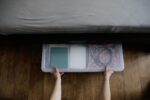It’s common to find tile floors in bathrooms, kitchens, and laundry rooms. Aside from looking marvelous, and they’re easy to clean and incredibly strong. Properly cleaning your tile will keep it lovely longer and bring out the best of your apartment. Learn how to clean your tile flooring correctly so you can continue to enjoy their beauty.
How Regularly Do Tile Floors Need to be Cleaned?
Routine cleaning varies on how much you walk across your floor combined with if you wear your shoes inside, as dirt and pebbles will cut the floor. Sweeping or vacuuming daily will prevent the floor from getting scratched.
The best practice is to mop your tile floor once each week, but don’t soak it too much otherwise you will do more harm than good.
What is Used to Clean Vinyl Tile Floors?
If you have new vinyl tile floors, they most likely do not need to be waxed. Wax, wet mopping, and shine cleaner will actually dull the finish instead of improving it.
To clean vinyl tile correctly, you will need to use a broom, dust mop, or vacuum for dirt and two sponges, an old cloth, and two buckets to wash. Should you choose, you can purchase vinyl floor cleaner or make one at home as well as use rubbing alcohol, WD40, and baking soda.
Cleaning Vinyl Tile Flooring
Begin by removing dirt, pebbles, and other debris from the floor with a broom or vacuum. After that, you will want to lift any stains.
Any ink, paint, lipstick, or crayon stains can be removed with rubbing alcohol. Use a sponge to spread rubbing alcohol over the stain.
Allow the alcohol to break down the stain for five minutes before using a clean sponge to wipe it up. Should you have any scuff marks from dragging your feet while wearing shoes, on your floor, use a little bit of WD40 on an old cloth to buff out the spots.
For any food or drink spills that have dried and hardened, baking soda and water can be combined into a paste. Cover the stain with the paste and use a wet towel to remove it.
With dirt and stains gone, you can wash the floor. If you purchased a cleaner, diligently read all instructions and perform them as written. A homemade solution can be made in a bucket by mixing one cup of vinegar to one gallon of hot water.
The acid content in the vinegar will lift dirt but won’t create a cloudy film. Trace amounts of dish soap can be added to the solution for more cleaning power. It is imperative not to drench the floors as the cleaning solution will seep under the vinyl tile and cause issues.
Ceramic and Stone Tile Cleaning
Compared to vinyl tile, ceramic and natural stone tile is stronger and looks nicer. Ceramic and natural stone is easier to clean, especially spills, and are immune to scratches.
Ceramic and natural stone can be chopped up to create any pattern to match any design theme making them an attractive choice. The hardest part of maintaining natural stone and ceramic tile floor is the grout.
What is Used to Clean Ceramic or Stone Tile Flooring?
Ceramic tile can be cleaned with a dish soap or an all-purpose cleaning product. Natural stone tile should be cleaned with a non-acidic, alkaline-based cleaning solution.
Make sure you have baking soda, hydrogen peroxide, or oxygen-based bleach powder as well. Additional supplies are a broom, dry mop or a vacuum, a wet mop, a stiff-bristled brush (or toothbrush), and two buckets.
Cleaning Ceramic or Stone Tile Flooring
Sweep or vacuum the floor to remove dust and dirt. With large, loose debris out of the way, you can clean the grout.
Unsealed grout will trap dirt that standard mopping will not remove. There are multiple products to clean grout, however, never mix cleaners as you might create a hazardous chemical reaction.
With the stiff-bristled brush or toothbrush, use one cleaner at a time and scrub at the grout. You can make a paste of baking soda and water or baking soda and hydrogen peroxide to spread along the grout and do the hard work for you, using a microfiber cloth to clean up the paste after it has worked its magic for five to ten minutes.
Once the grouting is clean, you can mop. Find the optimal cleaner for your ceramic or stone floor and adhere to each instruction provided. Adequately rinse the floor to prevent leaving behind a soapy residue that will become a major slipping hazard.




